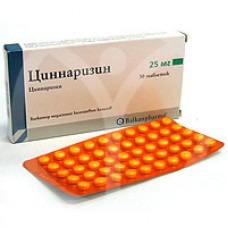Expiration date: 11/2026
Pharmacological action
Cinnarizin-calcium channel blocker with a pronounced effect on the vessels of the brain. It improves brain, as well as coronary and peripheral blood circulation. It violates the flow of calcium ions in the smooth muscle cells of blood vessels. Reduces the tone of smooth muscle arterioles, reduces the reaction to biogenic vasoconstrictor substances (adrenaline, noradrenaline, bradykinin). In patients with impaired peripheral circulation improves blood supply. Increases resistance of tissues to hypoxia. Reduces the excitability of the vestibular apparatus.
Indications
- disorders of cerebral circulation (vasospasm, atherosclerosis, traumatic brain injury, stroke);
- labyrinth disorder (for maintenance therapy in dizziness, tinnitus, nystagmus, nausea and vomiting labyrinthine origin);
- motion sickness (as a preventive measure);
- prevention of migraine attacks;
- Meniere's disease;
- prevention and treatment of peripheral circulatory disorders: arteriosclerosis obliterans, thromboangiitis obliterans, Raynaud's disease, diabetic angiopathy, acrocyanosis.
- as part of the complex therapy with rapid mental fatigue, irritability, reduced mood, memory disorders and the ability to concentrate.
Contraindications
- Hypersensitivity to the drug, pregnancy, lactation.
- Precaution: Parkinson's disease.
Composition
1 tablet contains 25 mg of Cinnarizine
Dosage and administration
In case of violations of cerebral circulation, the drug is prescribed for 25 mg 3 times a day.
In disorders of peripheral circulation Cinnarizine is used at 50-75 mg 3 times a day.
In case of motion sickness, 25 mg of Cinnarizine is taken for prophylactic purposes.
The maximum daily dose-225 mg (9 tab.).
Children aged 6-12 years are prescribed half the dose for adults.
The drug should be taken after meals.
Side effect
Perhaps: drowsiness, dry mouth, dyspeptic phenomena, allergic reactions in the form of skin rash.


